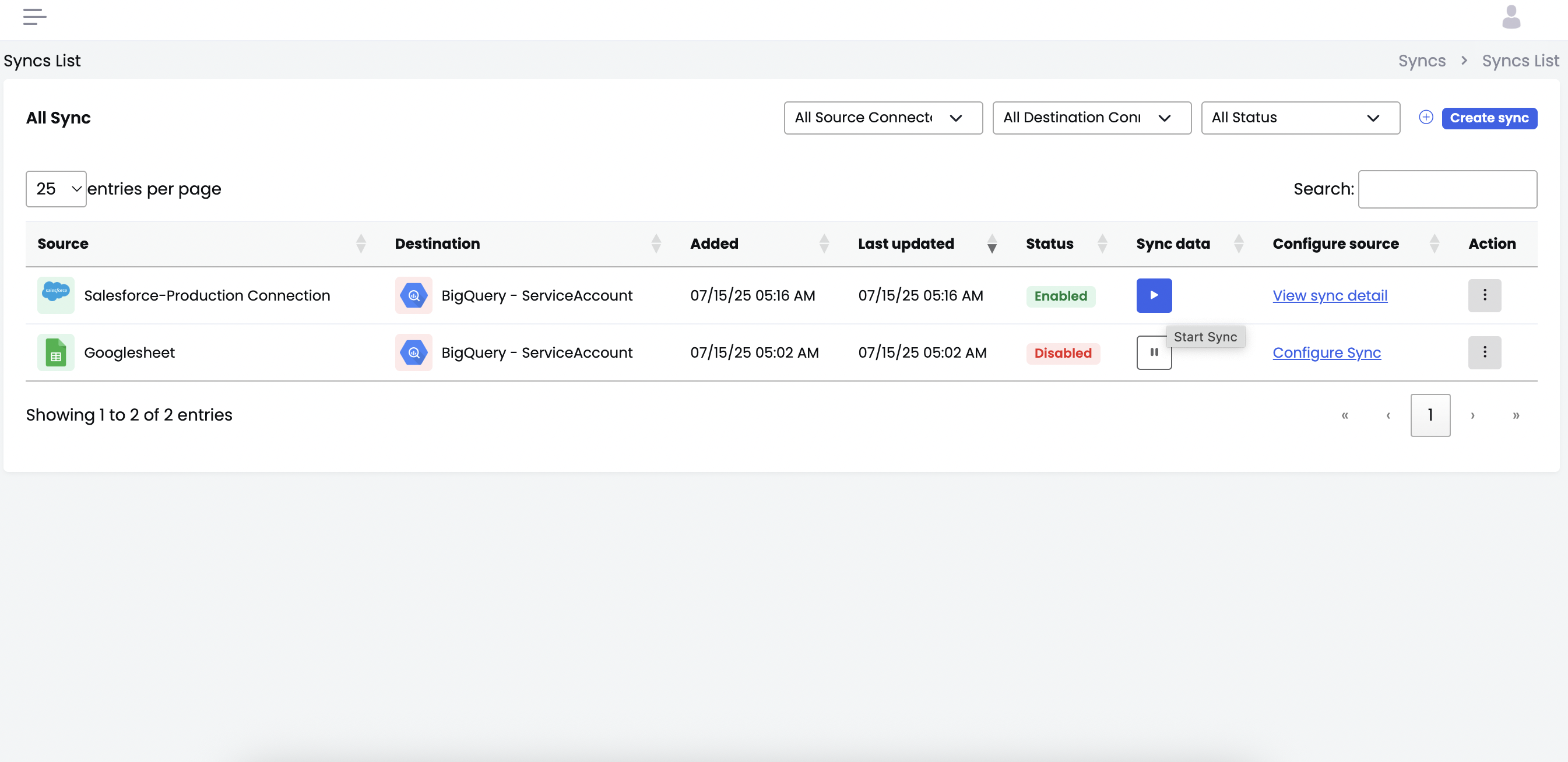Sync Management
The Syncs page is where you view, launch, pause, and configure all of your data pipelines.
🗂 1. All Syncs List
Navigate to Syncs from the sidebar to see every configured sync:

| Column | Description |
|---|---|
| Source | The source connection (e.g. Salesforce-Production). Click to view source details. |
| Destination | The destination connection (e.g. BigQuery-ServiceAccount). |
| Added | When this sync was first created. |
| Last updated | When you last edited or ran the sync. |
| Status | Enabled / Disabled – whether this sync is active. |
| Sync data | ▶️ Start now / ⏸ Pause – manually trigger or pause scheduled syncs. |
| Configure source | “View sync detail” or “Configure Sync” – jump into the sync-wizard to adjust settings. |
| Action | ⋮ menu to Edit, Test, Clone, or Delete this sync. |
ℹ️ Tip: Use the ▶️ button to force an immediate run, even if your next scheduled sync is far out.
🔍 2. Filtering & Search
At the top right you can:
- Source Connector filter – show only syncs from a specific source.
- Destination Connector filter – show only those going to a particular warehouse.
- Status filter – toggle between Enabled, Disabled, or All.
- Search – free-text search on sync name or connector names.
- Entries per page – choose 10, 25, 50, or 100 rows per page.
➕ 3. Create a New Sync
Click Create sync in the top-right to launch the sync-wizard. You’ll be guided through:
- Connect source – pick or reuse an existing source connection.
- Connect destination – choose or create your destination.
- Configure sync – name your sync, set frequency, toggle options (Bulk API, real-time, etc.).
- Map schema – select objects/tables and fields, apply transformations.
- Review & launch – verify configuration and start your first sync.
⚙️ 4. Sync Actions
Each sync’s ⋮ menu offers:
- Edit – change schedule, scope, or field mappings.
- Test – validate both source & destination connections without running a full sync.
- Clone – duplicate this sync (handy for similar pipelines).
- Delete – remove permanently (only if you have permission and sync is disabled).
::: warning Deleting a sync cannot be undone. Make sure you have archived any mapping settings you may need before deleting. :::
✅ 5. Status Meanings & Controls
| Button/Icon | Action | Description |
|---|---|---|
| ▶️ | Start Sync | Immediately run this sync, regardless of its schedule. |
| ⏸ | Pause Sync | Disable scheduled runs until you re-enable. |
| Enabled | Active | This sync will run automatically on its defined schedule. |
| Disabled | Inactive | Scheduled runs are off; you must manually ▶️ start each run. |
📘 Best Practices
- Name Clearly – include source→destination in the name, e.g.
SFDC→BQ_CRM. - Clone for Variations – clone an existing sync to tweak only frequency or object scope.
- Test After Edits – always click Test after changing credentials or mappings.
- Monitor Logs – use the Sync Detail page to inspect run history, errors, and performance.
That should give new users a clear, step-by-step reference for discovering, filtering, creating, and acting on their sync pipelines. Let me know if you’d like any more sections or examples!